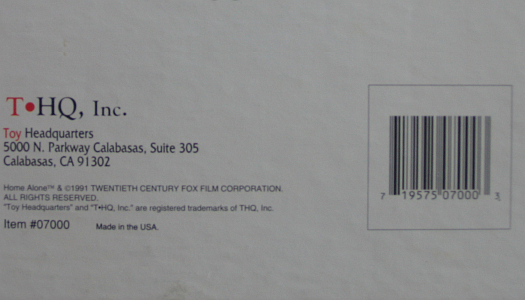
Home Alone: The Game

Home Alone: The Game
At times, running a pop culture website is a tedious affair. As the webmaster and namesake of SydLexia.com, I have final say over what appears on all subdomains of my site as well as the complete freedom to write about what the fuck I want to. But despite this, I still don't always get to write about the things that I want to write about. Behind the scenes, there is a never-ending power struggle between Syd the Writer, who wants to review random obscure shit that only five people actually care about, and Syd the Editor, who demands articles on subjects that will increase the site's traffic. And then, of course, there are the site's loyal fans, who constantly suggest games, movies, and other miscellaneous pop culture for me to review. If I were to take every single subject that had ever been suggested to me from the site's launch up through November 2008 and do one review per week, I'd have enough content to last me until 2021, at which point I would review the version of Sealab set in that year. But I don't like using other people's suggestions. The success of a website is completely dependent on its originality, and relying on other people for topic ideas demonstrates a complete lack of it. And it's a slippery slope. First you're borrowing ideas from other people, then you're borrowing quotes from them. Before you know it, you've become a complete fucking douchebag and a shameless plagiarist. The only person who will talk to you is the Irate Gamer, and that's only because he's hoping you'll say something funny that he can take credit for. I don't want to end up like that, so I avoid using suggestions, no matter how good they may be. Besides, I have plenty of ideas; I just don't have as much time to write as I'd like. But the worst thing about running a pop culture website is that there are only ten usable months in a year. I can write about whatever I want between January and September, but once October hits, I'm expected to do Halloween-related content all month. Then November comes around, and I've got another 30 days to write about whatever I want, but then we come to December and everyone expects me to write about Christmas shit. And I hate that. It's not that I hate Christmas and Halloween, I just hate feeling obligated to provide content centered around, especially when everyone else is doing it and when all the best material has been covered a million times before. And unfortunately, that's the stuff I'd like to review. I'd love to review Christmas Comes To Pac-Land, because it's hilariously bad, or A Garfield Christmas Special, but there's no fucking point. They've both been done dozens of times, and if I review one of them, I'll get an e-mail about how there's a better review on Geocities from 1998. That, or some jackass on Blogger.com who's starved for attention will discover that I used a few of the same obvious jokes as him and will accuse me of ripping him off. And while I can certainly stomach criticism from random idiots, I still don't feel I'd be doing you guys any favors by rehashing the same goddam stuff that I-Mockery, X-Entertainment, and less important, less hyphenated sites have reviewed in years past. So this Christmas, you get a review of a board game based on one of the best Christmas movies ever, Home Alone.
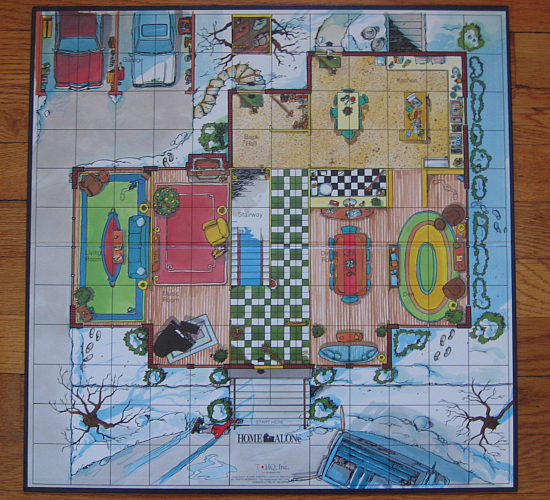
The Home Alone board game has a suggested age range of 6-12, which is the exact same demographic that the PG movie it was based on targeted. In order for a board game to successfully appeal to this demographic, it should have a relatively quick setup period and it should have simple rules that are easy to understand. This is due to the fact that children are all impatient fickle little bastards; they don't want to spend 15 minutes setting up a playfield or reading page after page of instructions, especially when they could be playing video games instead. Also, the game should be fun. Luckily, Home Alone: The Game is all three of these things.
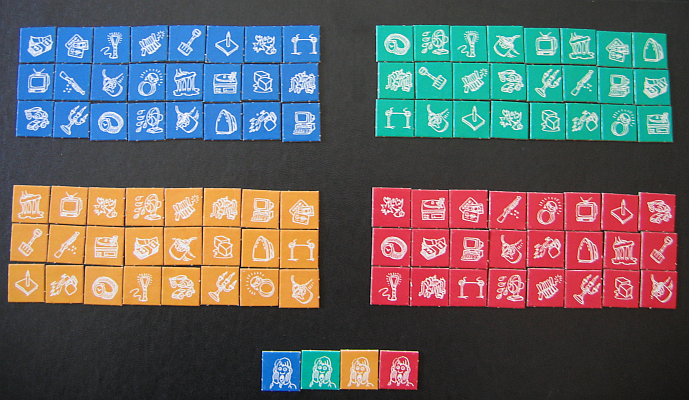
Home Alone: The Game allows 2-4 players to take on the role of Kevin McCallister as he defends his ancestral home from the invading Wet Bandits. The setup for the game is easy: each player is given 25 crudely drawn pieces to place face down on the board: 16 booby traps, 8 valuables, and 1 Kevin. These game pieces may be put anywhere on the board, with three exceptions: they may not be placed on the giant square marked "Home Alone", and they may not be placed on either of the two spaces with handle bars on them. Players can only put one of their game pieces on each square, but all four players may put a piece on the same square, should they choose to. But being as there are 138 usable squares on the board, there's no real reason for this to happen. But if all four of you want to hide the tarantula in the piano, you can. And if that wasn't already a metaphor for sex, it is now.
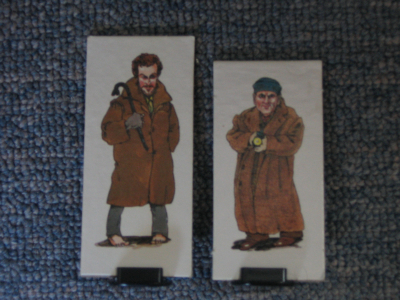
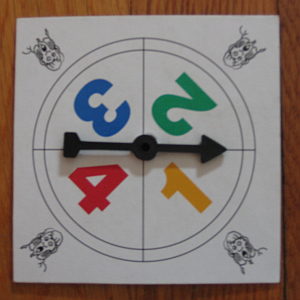
These are Marv and Harry, the Wet Bandits. They start the game on the giant square marked "Home Alone" right outside the McCallisters' front door. During each player's turn, that player gets to spin the wheel and move one of the crooks that number of spaces. If the crook lands on a space with game pieces on it, those pieces are revealed and placed on the scoreboard. Each booby trap revealed nets its owner one point, while each valuable revealed loses its owner one point. This system is somewhat illogical from a realistic standpoint, as it doesn't make sense that a crook could somehow pass over a giant nail or broken ornaments without being injured just because he didn't stop on that space, but in terms of gameplay, it was a necessary move; if crooks searched every square they walked over, the game would only last about five minutes. Since the pieces were all drawn by hand, it's sometimes hard to tell if a piece is supposed to be a valuable or a booby trap. For example, the valuable diamond ring has lines coming off it to signify that it's shiny, while the hot wire booby trap has the same lines coming off it to signify that it will fucking burn your fucking hand. And then there's the candlestick. If you're even dimly aware of the classic board game Clue - and you fucking should be - you know that the candlestick is one of the game's famous murder weapons. But in Home Alone: The Game, it's considered a valuable and not a booby trap. Luckily, the makers have provided you with a complete chart indicating what's a booby trap and what's not. You may notice that each booby trap set contains two paint cans, and that each one is slightly different. That's some great fucking effort right there.
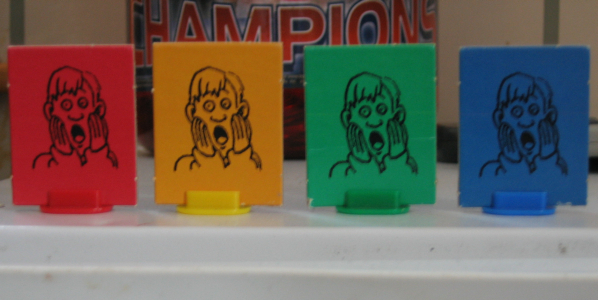
If a player's character square is uncovered by a crook, then their Kevin has been discovered, and they must immediately replace it with their Kevin marker. At this point, that player gets a free spin to move their Kevin away from the crook who found him. Subsequently, each player may move their Kevin piece the amount of spaces spun by the active player that turn, but not until after the player has moved a crook piece. A Kevin piece cannot trigger traps or collect valuables; his sole purpose is to avoid the crooks. To do so, Kevin may make use of either of the handle bars on the board, which will immediately take him to the treehouse square; the crooks cannot follow. Once a Kevin is revealed, the gameplay dynamic changes. Players will then attempt not only to trigger their own booby traps and discover each other's valuables, but also to catch a Kevin. If either crook manages to catch one of the large Kevin pieces, the game immediately ends.
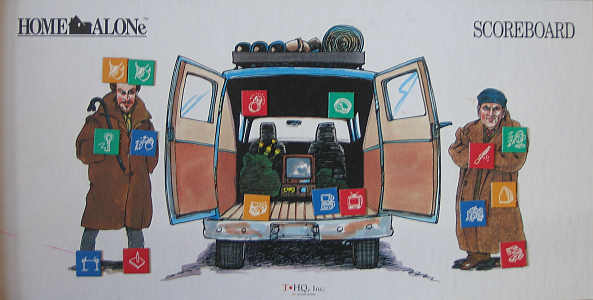
This is the game's fucking scoreboard, where valuables and booby traps are placed after they've been uncovered. Valuables are placed in the Wet Bandits' van, while booby traps are placed on the crook that discovered them. Once a Kevin has been caught and the game is over, each player counts up the number of booby traps they've set off and subtracts the number of valuables they've lost. Consequently, the highest score you can get is 16 and the lowest score you can get is -8, though both are damn near fucking impossible to pull off. And since this isn't fucking golf, the player with the highest score wins. All in all, despite being a cheaply made and cheap looking product, Home Alone: The Game is pretty damn fun. Also, it's nice and quick. Setup time runs around five minutes, while an average game will last about fifteen minutes. So if you get your ass kicked, no worries; there's plenty of time to play again. That's the problem with games like Monopoly and Battle Masters that take forever to set up and play. The game goes on for hours, then you lose and you want to fucking punch someone. Hell, I've seen games of Monopoly that *did* end with someone getting punched. Games like that ruin friendships. Home Alone: The Game will not cause such problems.
So in conclusion, Home Alone: The Game is pretty good, at least as far as board games go. The game does as good a job of recreating Kevin's heroic attempt to protect his house from the Wet Bandits as a board game can be expected to, and the experience doesn't feel nearly as tedious as the average board game. It's no Super Mario World or Sonic The Hedgehog, but it's a fun little distraction that will keep you entertained in times of power outages or also if you're poor. It's also important to note that Home Alone: The Game was put out by a company called Toy Headquarters, better known to many of you as THQ. In addition to this nice little board game, they published a pair of rather shitty Home Alone video games for the NES and Game Boy. They also published Wayne's World, Where's Waldo, a SNES port of Pit-Fighter, and many other notoriously bad games. Then in 1998, THQ partnered with the Aki Corporation to make one of the best wrestling games ever released, WCW/nWo Revenge for the Nintendo 64. The game was an instant classic, and two more hit games followed on the same engine, WWF Wrestlemania 2000 in 1999 and WWF No Mercy in 2000. After that, the partnership dissolved and THQ struck on their own and made a bunch of mediocre wrestling games that the fanboys will try and convince you are just as good as No Mercy; they're not even half as good. But they sell well, and between the Smackdown vs. Raw franchise, the Saint's Row games, and a critically acclaimed Wii game, de Blob, THQ earns enough money to churn out dreck like All Star Cheer Squad, Battle of the Bands, Bratz: Super Babyz, and World Championship Paintball. They really should hire me as a consultant; if they want to continue to spend all their WWE-related profits on moronic bullshit that no one will buy, I'd be more than willing to help design it.
Posted by: Syd Lexia
12/25/08
